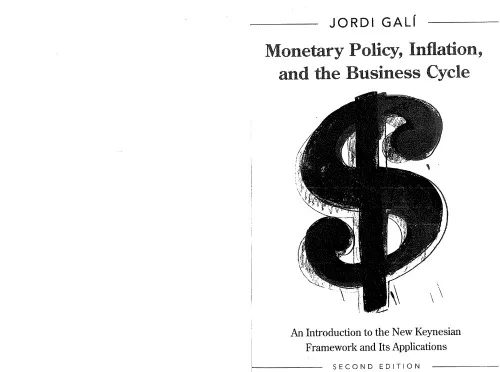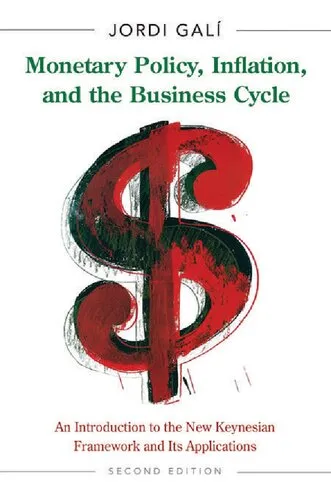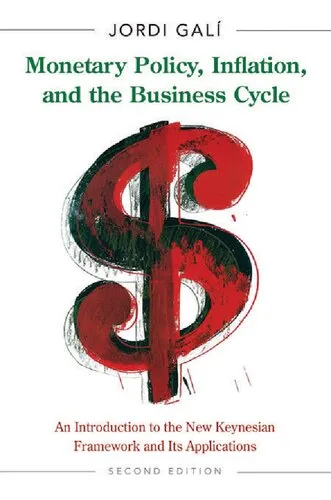Monetary Policy, Inflation, and the Business Cycle: An Introduction to the New Keynesian Framework
4.5
بر اساس نظر کاربران

شما میتونید سوالاتتون در باره کتاب رو از هوش مصنوعیش بعد از ورود بپرسید
هر دانلود یا پرسش از هوش مصنوعی 2 امتیاز لازم دارد، برای بدست آوردن امتیاز رایگان، به صفحه ی راهنمای امتیازات سر بزنید و یک سری کار ارزشمند انجام بدینکتاب های مرتبط:
معرفی کتاب
کتاب 'Monetary Policy, Inflation, and the Business Cycle: An Introduction to the New Keynesian Framework' نوشته جوردی گالی، یکی از مهمترین و بنیادیترین منابع در زمینه تحلیل اقتصاد کلان مدرن با استفاده از چارچوب New Keynesian است.
خلاصهای جامع از کتاب
این کتاب به بررسی نقش سیاستهای پولی در اقتصاد، تاثیرات تورم و نوسانات اقتصادی میپردازد. جوردی گالی در این کتاب به وضوح توضیح میدهد که چگونه چارچوب New Keynesian به ترکیب ابزارهای تحلیلی اقتصاد کلان و سیاست پولی کمک میکند. این چارچوب بر اهمیت انتظارات عقلانی، بازارهای ناقص و چسبندگیهای اسمی تأکید دارد. یکی از هدفهای اصلی کتاب، تحلیل رفتار اقتصادی هنگامی است که دسترسی به اطلاعات ناقص یا چسبندگی قیمتها به وجود میآید. کتاب همچنین به بررسی چگونگی تأثیرگذاری سیاستهای بانک مرکزی بر تورم و اشتغال، بهویژه در شرایطی که اقتصاد با شوکهای خارجی مواجه میشود، میپردازد.
یادگیریهای کلیدی
- درک عمیقی از مدلهای New Keynesian و اهمیت آنها در تحلیل سیاستهای پولی بدست آورید.
- نحوه تأثیر انتظارات عقلانی بر نوسانات اقتصادی و تصمیمگیریهای سیاستگذاران را درک کنید.
- آشنایی با چگونگی تعاملات بین تورم، بیکاری و سیاستهای پولی در چارچوب New Keynesian.
- تمرکز بر اهمیت چسبندگیهای قیمتی و نقش آنها در مدلسازی اقتصادی و سیاستگذاری.
- بررسی نقد و چالشهای موجود در چارچوبهای دیگر اقتصادی و مقایسه آنها با New Keynesian.
نقلقولهای معروف از کتاب
یکی از چالشهای اساسی برای سیاستگذاران پولی، حفظ توازن بین کنترل تورم و تقویت رشد اقتصادی است.
مدلهای New Keynesian از انتظارات عقلانی و چسبندگیهای قیمتی به عنوان اجزای کلیدی در نسبت به شوکهای اقتصادی بهره میگیرند.
چرا این کتاب اهمیت دارد
این کتاب برای اقتصاددانان، دانشجویان و سیاستگذاران به عنوان یک منبع اساسی درک پیچیدگیهای اقتصاد مدرن بسیار ضروری است. چارچوبی که گالی ارائه میدهد، بهویژه در محافل آکادمیک و دولتی برای تحلیل سیاستهای اقتصادی استفاده میشود. با افزایش نقش بانکهای مرکزی در اقتصاد جهانی و چالشهای پیش روی آنها، این کتاب ابزارها و نگرشهای جدیدی برای تحلیل و تصمیمگیریهای سیاستگذاران ارائه میدهد. علاوه بر این، دیدگاههای جدید اقتصادی که در این کتاب به اشتراک گذاشته میشود، باعث شده است تا بسیاری از محققان به بازنگری و تجدیدنظر در مدلهای اقتصادی موجود بپردازند و به تعمیق دانش خود از اقتصاد کلان بپردازند.
Introduction to New Keynesian Economics
Welcome to a comprehensive exploration of the New Keynesian framework through the lens of the book "Monetary Policy, Inflation, and the Business Cycle: An Introduction to the New Keynesian Framework." This work stands as a foundational text that synthesizes theoretical insights and empirical findings to provide a cohesive understanding of monetary policy and its intersection with inflation and economic cycles.
Detailed Summary of the Book
"Monetary Policy, Inflation, and the Business Cycle" offers a clear and accessible introduction to the primary features of the New Keynesian model—a framework that integrates price and wage rigidities into macroeconomic analysis. This book sets out to demystify complex economic concepts such as dynamics of inflation and output under various monetary policy rules. The text discusses how these models illuminate the mechanisms of price setting, providing insights into optimal policy design and implementation. Importantly, it addresses both theoretical constructs and practical applications, making it an invaluable resource for those aiming to understand contemporary macroeconomic policy challenges.
Central to the book is the systematic examination of the dynamic stochastic general equilibrium (DSGE) models, with particular attention to their implications for monetary policy. Through a careful calibration and estimation approach, readers are introduced to the quantitative dimensions of the New Keynesian framework, offering a bridge between theoretical abstraction and real-world policy making.
Key Takeaways
- The role of nominal rigidities in shaping economic dynamics.
- An understanding of the policy implications of the output-inflation trade-offs.
- Insights into how central banks can use interest rate rules to stabilize the economy.
- The importance of expectations in formulating and implementing successful monetary policies.
Famous Quotes from the Book
"Economic policy must account for not only the immediate impacts but also the dynamic expectations of future conditions."
"Price stability is not merely an objective; it is a precondition for sustainable economic growth."
Why This Book Matters
In the evolving landscape of global economies, understanding the insights offered by New Keynesian economics is crucial. This book is not just a theoretical text; it serves as a practical handbook for policymakers, economists, and students alike. By bridging the gap between classic Keynesian approaches and modern economic realities, it equips readers with the tools to critically analyze and interpret the effects of monetary policy decisions.
As our world faces new economic challenges, from financial crises to unexpected economic shocks, the principles outlined in this book become even more relevant. They offer a guiding framework to understand how inflation dynamics and business cycles interact with policy interventions, enhancing our ability to foster economic stability and growth.
دانلود رایگان مستقیم
شما میتونید سوالاتتون در باره کتاب رو از هوش مصنوعیش بعد از ورود بپرسید
دسترسی به کتابها از طریق پلتفرمهای قانونی و کتابخانههای عمومی نه تنها از حقوق نویسندگان و ناشران حمایت میکند، بلکه به پایداری فرهنگ کتابخوانی نیز کمک میرساند. پیش از دانلود، لحظهای به بررسی این گزینهها فکر کنید.
این کتاب رو در پلتفرم های دیگه ببینید
WorldCat به شما کمک میکنه تا کتاب ها رو در کتابخانه های سراسر دنیا پیدا کنید
امتیازها، نظرات تخصصی و صحبت ها درباره کتاب را در Goodreads ببینید
کتابهای کمیاب یا دست دوم را در AbeBooks پیدا کنید و بخرید
1372
بازدید4.5
امتیاز0
نظر98%
رضایتنظرات:
4.5
بر اساس 0 نظر کاربران
Questions & Answers
Ask questions about this book or help others by answering
No questions yet. Be the first to ask!















